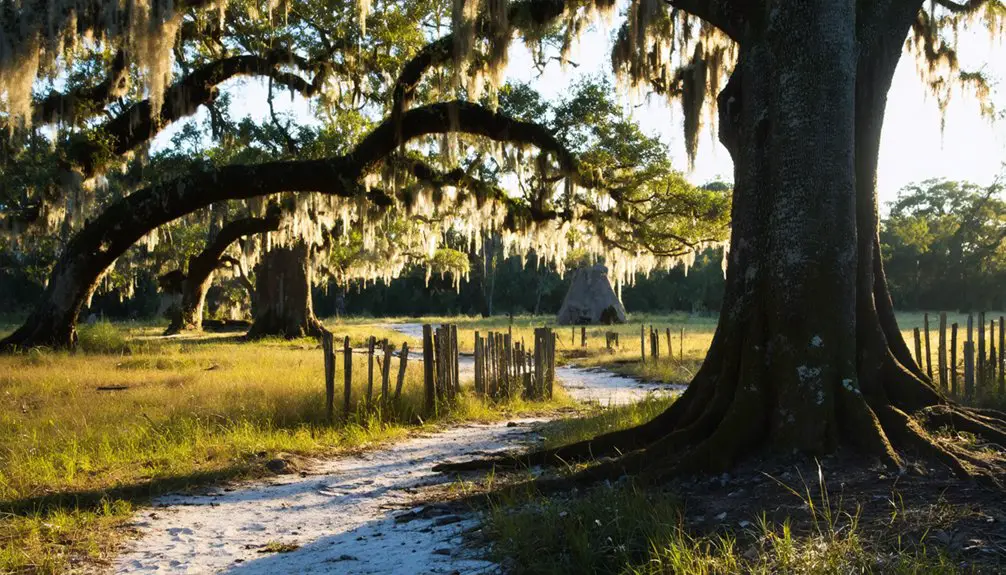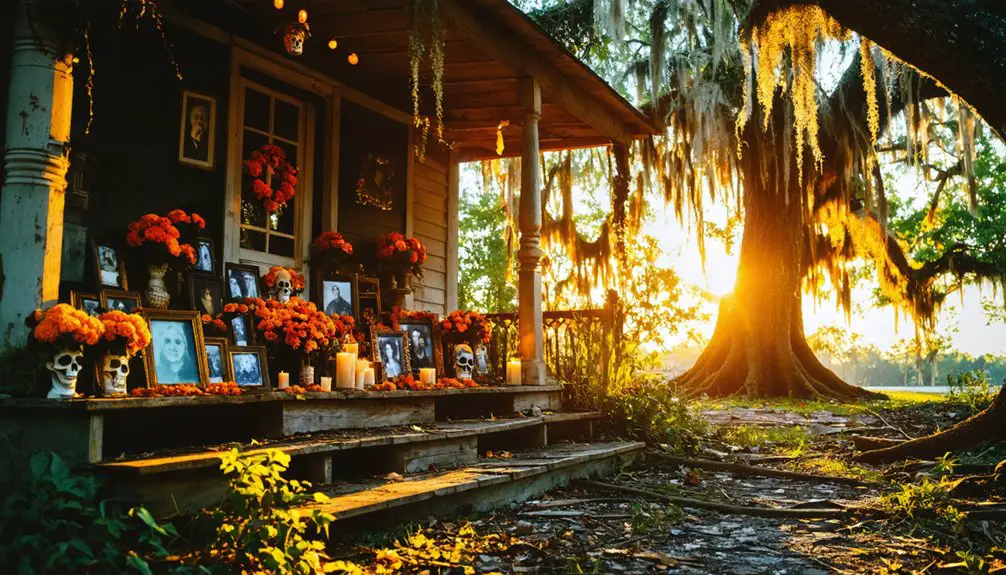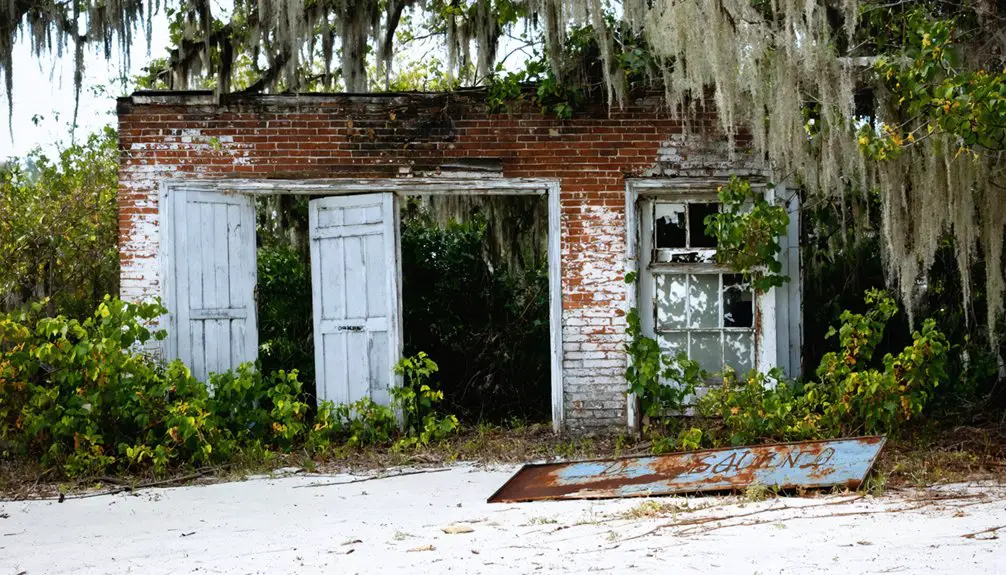You’ll find Ortona’s ghost town ruins in Glades County, Florida, where two fascinating stories converge. Ancient Native Americans first settled here 1,600 years ago, creating North America’s longest prehistoric canal system connecting Lake Okeechobee to the Gulf. Later, pioneer families established a thriving agricultural community named by Jerome G. Attanasio in the 1920s. Though the town declined by decade’s end, its preserved Indian Mound Park holds centuries of hidden Florida history.
Key Takeaways
- Ortona declined in the late 1920s due to economic factors and transportation changes that diverted trade routes away from the community.
- Once a thriving settlement with Native American heritage and pioneer agriculture, Ortona transformed into a ghost town as younger residents moved to coastal cities.
- The Great Depression severely impacted Ortona’s agricultural markets, forcing many families to abandon the area permanently.
- Changes in river transportation diminished Ortona’s importance as a trading hub, contributing to its eventual abandonment and ghost town status.
- Today, Ortona exists primarily as a historical site featuring Indian mounds, archaeological remains, and an annual Cane Grinding Festival celebrating its heritage.
The Ancient Native American Legacy
While many ghost towns in Florida emerged during the colonial era or later, Ortona’s history stretches back over 1,600 years to when Native Americans first established a sophisticated settlement in northeastern Glades County.
You’ll find evidence of their engineering prowess in some of North America’s longest prehistoric canals, which connected Lake Okeechobee to the Caloosahatchee River.
These ancient people, likely ancestors of the Calusa, built impressive burial mounds that reveal their complex cultural connections to groups as far away as the Ohio River Valley. Their burial practices included ceremonial mounds where they interred their dead and possibly held community gatherings.
Through artifacts discovered at the site, you can trace their extensive trade networks and sophisticated understanding of water management in Florida’s challenging wetland environment. Today, the neglected site struggles with preservation challenges and erosion issues. The village reached its peak occupation between 550-800 A.D., establishing itself as a crucial center of commerce and culture.
Engineering Marvels of the Calusa People
As you explore Ortona’s ancient landscape, you’ll discover the remarkable engineering achievements of the Calusa people, who transformed Florida’s coastal environment into a sophisticated network of watercourts, canals, and artificial islands.
The Calusa engineering prowess shows in their innovative tidal systems, where they built massive rectangular enclosures to trap fish using the natural ebb and flow of water. The military elite force helped coordinate and protect these impressive engineering projects. At their peak, the Calusa population numbered between 20,000 to 50,000 people.
You can still see remnants of their grand canal on Mound Key, stretching nearly 2,000 feet and serving as an ancient marine highway. They constructed impressive shell mounds reaching 30 feet high, supporting massive council houses that could hold up to 2,000 people.
Their tools, crafted from shark teeth, shells, and plant fibers, enabled them to build these incredible structures while maintaining perfect harmony with their coastal environment.
Early Pioneer Settlement and Community Life
The pioneer settlers of Ortona arrived in the same lands where the Calusa once demonstrated their engineering mastery.
You’d find these early homesteaders, including the Townsend and Williams families, living in simple dwellings crafted from cane poles and cabbage palm fronds. They’d gather materials from places like Fisheating Creek, working together to build each other’s homes.
The pioneer lifestyle centered around sugarcane cultivation, with neighbors pitching in during grinding season. The settlers built their community near ancient Indian mounds that dated back to around 300 A.D. Much like the relics of Saint Thomas brought to the original Ortona in Italy, these mounds held historical significance for the area.
When grinding season arrived, pioneering neighbors banded together, united in their shared labor of cultivating and processing sugarcane.
You’ll notice how community cooperation shaped their daily lives – from constructing the Ortona Holiness Church to sharing hunting and fishing spots along the Caloosahatchee River.
Jerome G. Attanasio named the settlement after his Italian birthplace in the 1920s, hoping to attract grape growers, though sugarcane proved more successful in sustaining the tight-knit community.
Agricultural Heritage and Sugarcane Production
Since the earliest days of settlement, sugarcane has defined Ortona’s agricultural identity, with pioneer families maintaining their own stands despite the challenges of acquiring tools and supplies. Traditional mule power was essential for grinding sugarcane before modern machinery arrived.
The fertile lands along the Caloosahatchee River and South Florida’s warm climate created ideal conditions for sugarcane cultivation. You’ll find that early settlers relied heavily on community cooperation for syrup production, sharing resources and labor during the intensive grinding process. The modern industry generates over two billion dollars in economic activity across Florida.
- The Ortona Cane Grinding Festival, established in 1979, preserves this heritage through live demonstrations of traditional syrup-making methods.
- Local families produced cane syrup as their primary sweetener before commercial sugar became widely available.
- The formation of the Sugar Cane Growers Cooperative in 1960 transformed small-scale farming into a major industrial operation, with the Glades Sugar House becoming one of the world’s largest raw sugar mills.
Jerome G. Attanasio’s Vision for Ortona
While sugarcane shaped Ortona’s early agricultural foundation, Jerome G. Attanasio had a bold vision for transforming his 360-acre purchase into a thriving agricultural community.
Drawing inspiration from his Italian birthplace, Attanasio’s aspirations centered on establishing a grape-growing haven alongside diverse farming operations. You’ll find his pioneering spirit reflected in the 1924 planting of 500 Carmen Grape rootstock across six acres.
Attanasio’s vision transformed virgin Florida soil into a Mediterranean-inspired vineyard, planting hope alongside his cherished Carmen grapes.
Community collaboration became the cornerstone of Attanasio’s development strategy. He encouraged settlers to work together, using local materials like cane poles and cabbage fan palms to build homes.
You can trace his influence in the cooperative construction of the Ortona Holiness Church and shared sugarcane processing efforts. Though the Great Depression later dampened his plans, Attanasio’s vision laid the groundwork for Ortona’s permanent settlement.
The Decline of a Thriving Settlement
Despite its early promise and Attanasio’s ambitious vision, Ortona began a gradual decline in the late 1920s as multiple forces converged against the settlement.
Economic factors and transportation changes struck decisive blows to the town’s prospects. You’d have seen the impact of shifting trade routes as newer roads bypassed the once-bustling community, cutting off essential commerce that had sustained local businesses. The town’s fate mirrored the boom-bust cycles characteristic of many Florida settlements. The area depended heavily on cattle barons who owned most of the surrounding land, limiting opportunities for new development.
- The Great Depression devastated the region’s agricultural markets, forcing many farming families to abandon their properties.
- Changes in river transportation patterns reduced Ortona’s strategic importance as a trading hub.
- Younger residents increasingly migrated to Florida’s growing coastal cities in search of better opportunities.
These combined pressures transformed what had been a thriving settlement into another of Florida’s ghost towns, leaving behind only scattered remnants of its former vibrancy.
Preserving History at Ortona Indian Mound Park

When you visit Ortona Indian Mound Park today, you’ll find one of North America’s most impressive examples of prehistoric engineering – an extensive network of canals and earthworks built by the Calusa people between 300-1150 AD.
You can explore the site’s 60 acres via a 270-foot wooden boardwalk that winds through ancient village mounds and waterways, though some structures now face preservation challenges from erosion and insufficient maintenance.
The park’s interpretive displays and annual Cane Grinding Festival help keep Florida’s Native American heritage alive while educating visitors about the remarkable achievements of these early engineers who transformed the landscape through their sophisticated hydraulic knowledge.
Ancient Engineering Marvel
Among Florida’s most remarkable archaeological treasures, the Ortona Indian Mound Park showcases the engineering prowess of the ancient Calusa Indians through its extensive network of canals and earthworks.
You’ll discover ancient structures dating back to 250 AD, when indigenous engineering shaped this landscape into an impressive system of connected waterways for transportation.
- A serpent-shaped mound corresponding to the Serpens Caput constellation reveals the Calusa’s sophisticated astronomical knowledge.
- Mound A spans 128 feet across and rises 8.2 feet, containing animal bones and artifacts that tell the story of early Native American life.
- The canal network demonstrates advanced construction techniques, connecting various hammocks and providing essential transportation routes.
Today, you can explore these remarkable achievements via the Ortona Indian Mound Trail, though portions of these historic features face preservation challenges.
Cultural Heritage Protection
The preservation of Ortona Indian Mound Park’s rich archaeological heritage falls under careful stewardship since its 1973 transfer to Glades County by Lykes Bros., Inc.
You’ll find cultural preservation efforts focused on protecting the 60-acre property through strategic infrastructure, including a 270-foot boardwalk and designated visitor areas that help minimize impact on sensitive archaeological features.
Heritage management faces ongoing challenges, as significant portions of the prehistoric village remain in private hands.
While the park’s creation in 1989 formalized protection efforts, you’ll notice that erosion and limited funding continue to threaten the site’s earthworks and canals.
Local initiatives like the Ortona Cane Grinding Festival and community outreach programs work to raise awareness, though the site needs additional support for thorough archaeological protection and maintenance.
Modern Educational Resource
Situated along ancient Native American trade routes, Ortona Indian Mound Park serves as an essential educational resource for understanding Florida’s prehistoric cultures.
You’ll discover a 60-acre outdoor classroom featuring interpretive displays and educational kiosks that detail the site’s rich archaeological heritage. Through community engagement and educational programs, you can explore the park’s historical significance during the annual Ortona Cane Grinding Festival or guided tours.
- Walk the 270-foot boardwalk to view burial mounds and ancient canal systems built by indigenous peoples between A.D. 400-800
- Learn about the sophisticated engineering of the Ortona people through informative panels and archaeological exhibits
- Experience hands-on demonstrations and traditional activities that connect you to both prehistoric and early settler histories
Modern-Day Cultural Celebrations

You’ll find the heart of Ortona’s cultural heritage at the annual Cane Grinding Festival, held every February at Indian Mound Park, where residents demonstrate traditional sugarcane processing methods from the 1800s.
Throughout the year, local historical reenactments bring to life the early settler experience, showcasing pioneer skills like building homes with cane poles and palm fronds.
The park’s cultural events also honor the engineering achievements of the ancient Calusa people, whose earthworks and canal systems date back to A.D. 400, creating a bridge between prehistoric Native American heritage and modern celebrations.
Cane Grinding Festival Today
Every first Saturday in February, visitors gather at Ortona Indian Mound Park for a cherished celebration of Florida’s pioneer heritage – the annual Cane Grinding Festival.
You’ll experience authentic sugarcane traditions dating back to the 1800s while enjoying live bluegrass music and watching demonstrations of historic syrup-making methods.
The festival’s significance extends beyond entertainment, serving as a living bridge between past and present at this archaeological treasure in Glades County.
You’re free to explore the grounds where Calusa Indians once lived, while participating in modern festivities.
- Watch Florida Flywheelers showcase antique farming equipment
- Enter contests like cake baking and pet costume competitions
- Browse flea market vendors offering local crafts and food
Don’t forget your lawn chair – you won’t want to miss this unique blend of pioneer spirit and community celebration.
Historical Reenactments and Events
Throughout the year, Ortona Indian Mound Park transforms into a living museum where historical reenactors bring Florida’s rich past to life.
You’ll experience authentic portrayals of 19th-century settlers during the annual Cane Grinding Festival, where historical reenactment techniques showcase traditional sugarcane milling and syrup-making. Festival planning guarantees you’re immersed in period-accurate demonstrations of pioneer survival skills and daily routines.
Beyond settler history, you’ll discover the site’s ancient heritage through guided archaeological tours and Native American cultural celebrations.
Local historical societies and archaeologists collaborate to present lectures, interpretive hikes, and hands-on activities that reveal Ortona’s significance from 300 AD through the 1600s.
These events highlight both the prehistoric mound builders’ engineering feats and the region’s crucial role in early Florida trade networks.
Native American Heritage Celebrations
Modern celebrations of Native American heritage continue to honor the region’s Indigenous roots through vibrant cultural events and exhibitions.
You’ll find rich cultural exchanges throughout South Florida, particularly at the Ah-Tah-Thi-Ki Museum on the Big Cypress Seminole Indian Reservation, where native celebrations showcase traditional art, dance, and crafts year-round.
- The annual Seminole Tribal Fair & Powwow at the Hard Rock Hotel & Casino Hollywood features exhibition dancing, drumming competitions, and authentic Indigenous vendors.
- Educational workshops at the University of Florida offer hands-on experiences in traditional beading and dance during Native American Heritage Month.
- The Miccosukee and Seminole Tribes maintain active cultural presences through tourism initiatives and public events, ensuring their heritage remains vibrant in modern Florida.
Archaeological Significance and Conservation Efforts
Located along Florida’s Caloosahatchee River, the Ortona archaeological site spans over 500 acres and stands as one of the state’s most significant prehistoric settlements.
You’ll find remarkable earthworks and an intricate canal system that once connected Lake Okeechobee to the Gulf of Mexico, showcasing the engineering prowess of indigenous peoples between 300-1150 AD.
The site’s archaeological preservation faces serious challenges today.
Modern development, sand mining, and unauthorized artifact hunting have damaged this cultural treasure.
While the Florida Archaeological Conservancy works to protect Ortona’s remaining features, much of the land remains in private hands.
You can still explore portions of the extensive canal network, which at 20 miles long, represents North America’s longest indigenous-built waterway system.
Frequently Asked Questions
What Is the Current Population of Ortona, Florida?
You’ll find that Ortona’s history reflects dramatic population trends, as this former community is now classified as a ghost town with effectively zero permanent residents according to current demographic records.
Are There Any Remaining Original Buildings Still Standing in Ortona Today?
You won’t find any original buildings still standing there today, despite historic preservation efforts. The area’s architectural significance now lies mainly in its preserved Native American mounds and earthwork ruins.
Can Visitors Stay Overnight at Ortona Indian Mound Park?
Yes, you can stay overnight at the park’s south campground, but you’ll need reservations and must follow strict camping regulations. Sites 31-51 offer full-service overnight accommodations with hookups and amenities.
What Happened to the Grape Cultivation Industry Started by Attanasio?
Like a withered vine, Attanasio’s grape history crumbled when Pierce’s disease devastated European varieties. You’ll find the agricultural decline worsened during the Great Depression, leading to complete abandonment of the venture.
Is There a Museum or Visitor Center in Ortona?
You won’t find a dedicated museum or visitor center in Ortona. While exploring Ortona’s history, you’ll discover that Ortona Indian Mound Park serves as the main outdoor attraction without formal facilities.
References
- https://en.wikipedia.org/wiki/Ortona
- https://www.wgcu.org/show/gulf-coast-life/2024-04-10/forgotten-park-series-unearths-ortona-indian-mound-parks-history
- https://etchey.wordpress.com/2009/11/15/sunday-drive-to-citrus-center/
- https://www.youtube.com/watch?v=DgvQEWDsQLM
- https://en.wikipedia.org/wiki/List_of_ghost_towns_in_Florida
- https://en.wikipedia.org/wiki/Ortona_Prehistoric_Village
- https://visitglades.org/come-play/ortona-indian-mound/
- https://files.floridados.gov/media/32346/nativeamericanheritagetrail.pdf
- https://granger.substack.com/p/mounds-canals-and-history-ortona
- https://www.calusalandtrust.org/who-were-the-calusa-



